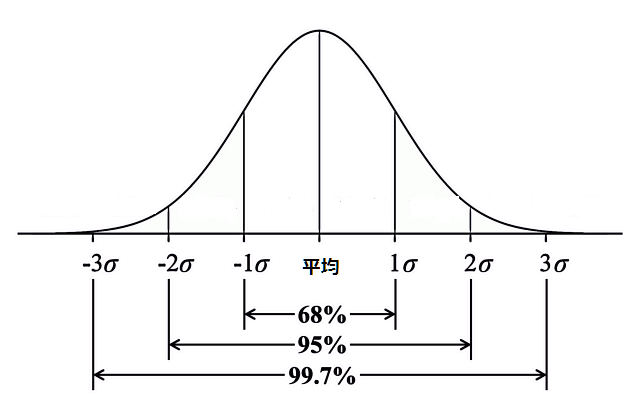日本語は最後にあります。
Listed in English, Chinese, and Japanese in that order.
Please note that this is an automatic translation.
英文、中文和日文,依次排列。
请注意,这是一个自动翻译,任何错误的翻译都应予以确认。
Familiar Statistics (5)
Recently, I tuned into a fascinating lecture on variance and sigma at the Open University of Japan. This topic fundamentally explores deviation from the mean, and how it's measured using concepts like standard deviation, variance, and unbiased variance. Importantly, these are applied in the probability distribution model known as the Normal distribution.
Sigma rules (1, 2, and 3) are important in this study. Essentially, they signify that 68.3% of data fall within ±1 sigma (emphasizing central tendency), 95.4% within ±2 sigma (marking the threshold of likelihood), and 99.7% within ±3 sigma. The Z-score standardizes these numbers.
The Japanese Standards Association, founded in 1945, employs these statistical understandings for quality control, enabling the diagnosis and resolution of critical problems and promoting international competitiveness.
Globally, Six Sigma (using the DMAIC method: Define, Measure, Analyze, Improve, Control) and ISO standards like 13053, 18404, and 16336 are significant in applying statistical methods for process improvement and new technology development. These tools are helping organizations meet customer requirements, improve processes, and develop robust, high-quality products.

熟悉的统计学 (5)
最近,我在日本开放大学看了一场关于如何使用西格玛测量差异的精彩讲座。在这次讲座中,我深入了解了与平均值的偏差、标准偏差、方差和无偏方差等概念。这些概念在正态分布的概率分布模型中得到应用。
西格玛规则是这一主题中的重要组成部分。它包括1西格玛、2西格玛和3西格玛规则。根据这些规则,我们可以得知68.3%的数据落在±1西格玛内(体现了中心趋势),95.4%的数据落在±2西格玛内(此范围外的事件被认为是不太可能发生的),99.7%的数据落在±3西格玛内。Z得分(Z-score)是将这些数值标准化的一种方法。
日本标准协会在1945年成立,旨在提高日本的技术能力和加强其国际竞争力。该协会引入了统计质量控制,包括选择关键问题、缩小原因范围、分析原因,以及将具体措施转化为内部标准。这些都有助于提升组织的效率和质量。
在全球范围内,六西格玛和ISO标准(如ISO 13053, ISO 18404和ISO 16336)都在过程改进和新技术开发中应用了统计方法。这些工具帮助组织满足客户需求、改进过程并开发出高质量的产品。这就是我在讲座中学到的有关使用西格玛测量差异的精彩知识,希望这也能帮助你们更好地理解和应用统计学。

身近な統計 (5)
先日、放送大学の講義を視聴しました。「バラつきの大きさを測る、シグマの活用」という副題のもと、統計学の理解を深めました。
まず、基本的な統計概念について学びました。平均値からの差を偏差と呼び、偏差の平方の平均を分散とします。この分散の平方根を標準偏差と言います。また、母集団全体のバラつきを推測するためには、不偏分散を用います。これらの概念は、確率分布モデルである正規分布N(Xbar, S^2)において重要です。
次に、シグマの法則について学びました。この法則は1シグマ、2シグマ、3シグマの3つの法則で構成されています。これによれば、データの68.3%が±1シグマの範囲内に、95.4%が±2シグマの範囲内に、そして99.7%が±3シグマの範囲内に集まることを示しています。また、標準化された値をZスコアと呼びます。
その後、日本規格協会の設立とJIS規格について学びました。1945年に設立された同協会は、技術力向上と国際競争力強化を目指し、統計的品質管理を導入しています。この管理手法には、重要な問題の選定や原因の絞り込み、要因の解析、具体策を社内標準への変換などが含まれます。
また、海外ではシックスシグマやISO規格が統計学の手法を用いています。これらはプロセス改善における定量的方法であり、顧客要求の定義、測定、分析、改善、制御(DMAIC法)を含みます。特にISO規格は、新技術や製品開発の統計的手法の応用に重要であり、ロバストパラメータ設計(タグチメソッドの一つ)も含まれます。
この講義を通じて、シグマを活用した統計学の力強さを再認識しました。これらの知識は、日々の生活やビジネスの中で、さまざまな情報を理解し、適切な判断を下すために役立つことでしょう。

office Hana An / 小庵